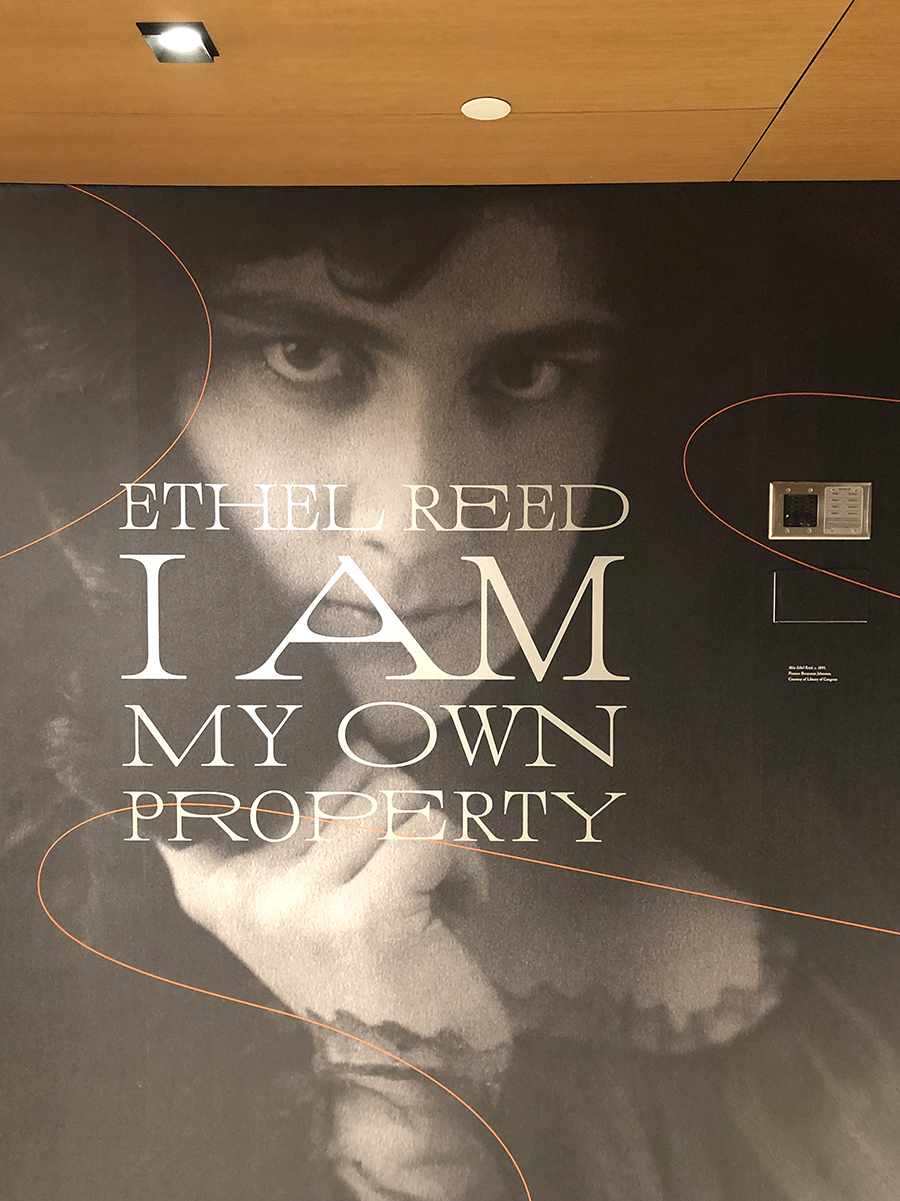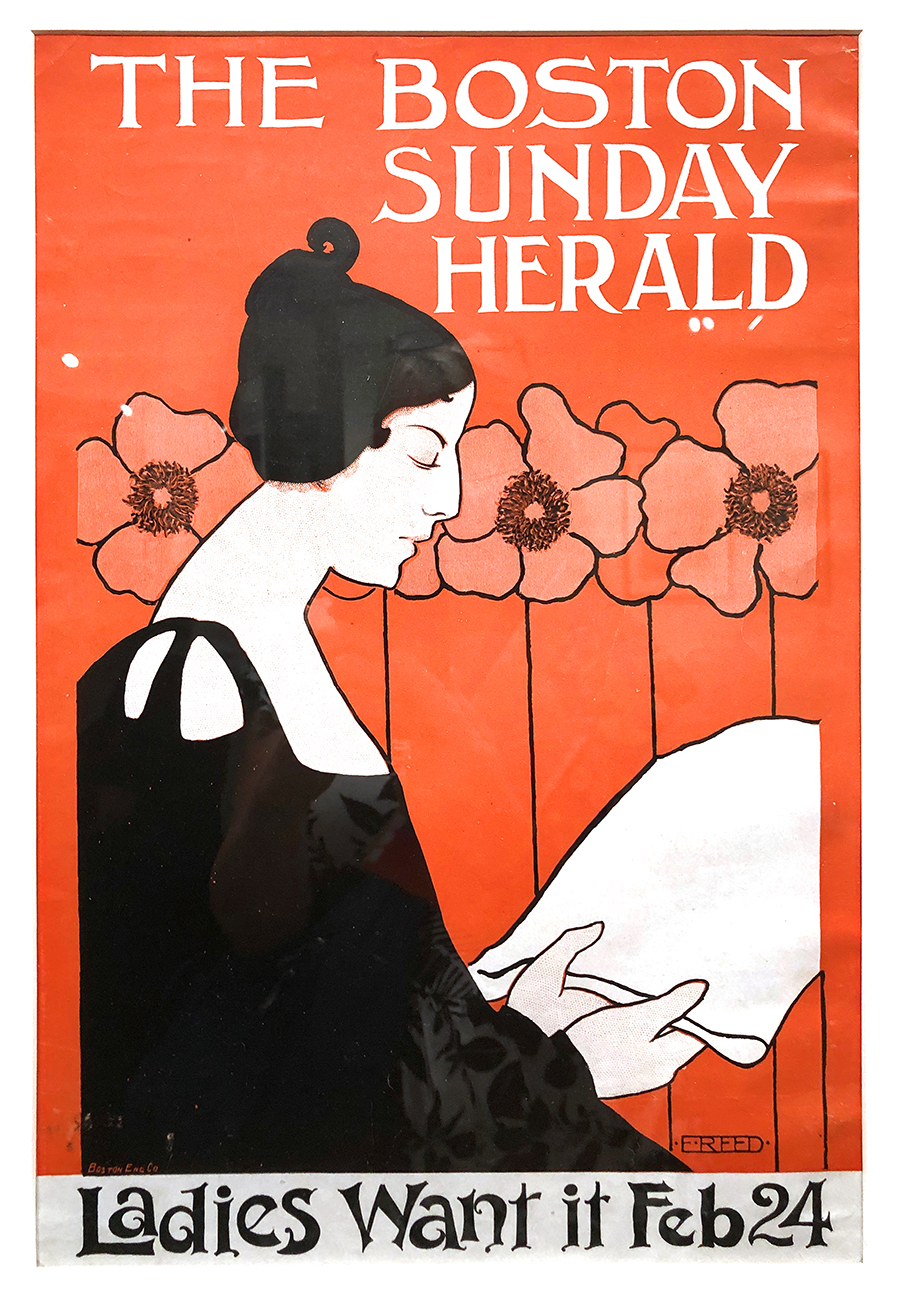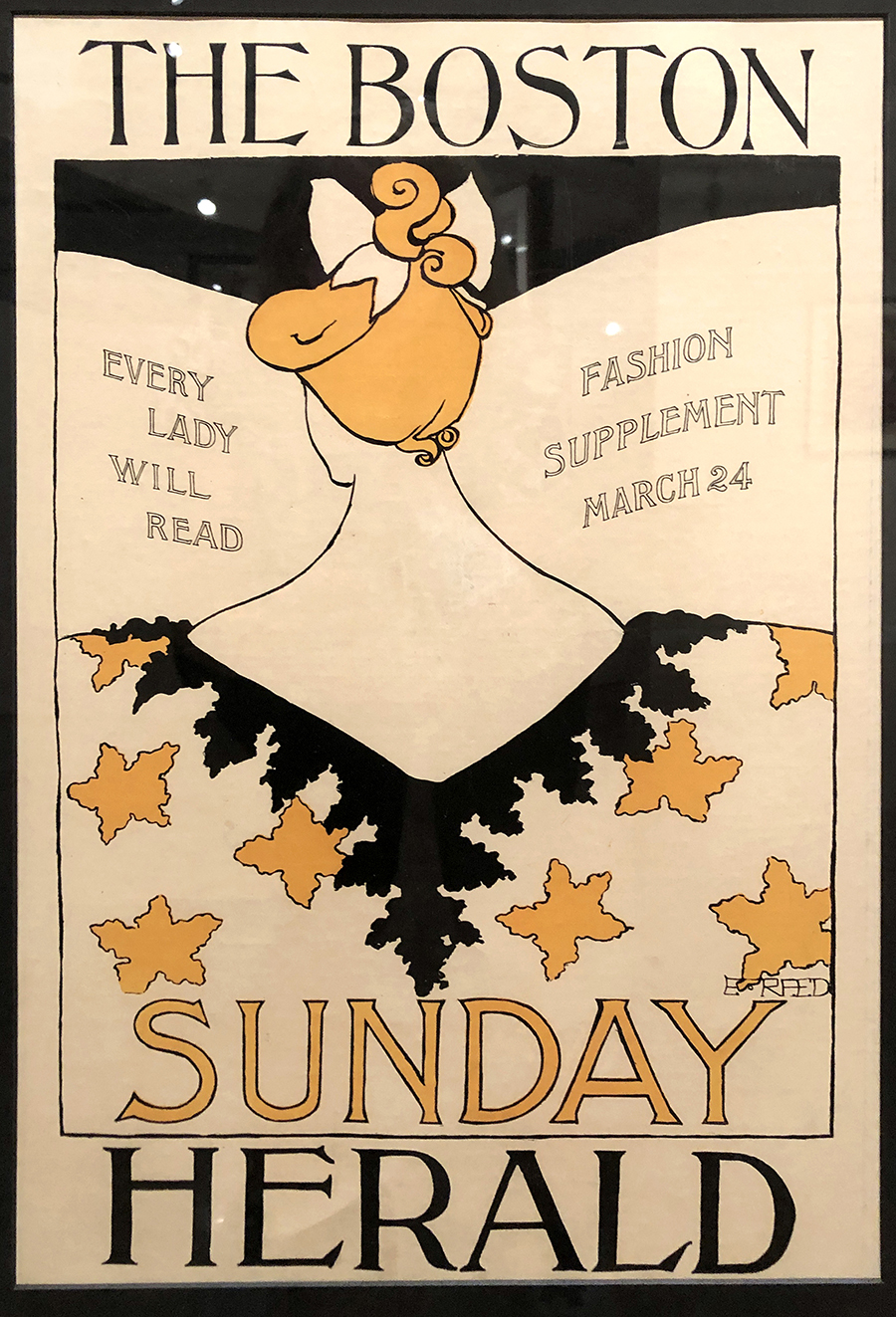
February 7, 2023
Midterm Reflections on the Ethel Reed Show at Poster House

Ethel Reed exhibition at Poster House. Summer 2022. Entry wall signage, with photograph of Miss Ethel Reed circa 1895 by Francis Benjamin Johnson, Courtesy of Library of Congress.
I was delighted to catch the Ethel Reed exhibit this summer on my first visit to Manhattan’s Poster House, an excellent (relatively new) design museum dedicated to the art of the poster. The museum had three superb shows, a large and muscular show on Russian constructivist posters and a very nice downstairs hallway exhibit on the history of women’s roles as portrayed in show cards from Hollywood. It was a perfect contextual entryway to step through to the show on Ethel Reed. I enjoyed Reed’s work, but after my first impressions, this show has been nipping at the edges of my daily practice, niggling me, and requesting further attention since this summer. It’s a story I would like to share with you, if you don’t know it already.
Ethel Reed, a designer/illustrator discovered as a very young woman in 1895, rose to the top of her field creating designs for the Boston publishing industry. A few short years later, she disappeared entirely — she has existed as a graphic design mystery for nearly a century. Her beguiling curvilinear drawings of women, flirtatious, youthful, joyous, and possessed of their own charismatic power, made her work daring and just-on-the-edge of risqué for the audiences of the 1890’s.

Ethel Reed. Ladies Want it Feb 24. 1895. Color Lithograph
While looking at her work, It confounds me that I did not know more about Ethel Reed before now. Reed was a contemporary of Kate Chopin, active at the tail-end of the suffragette movement; she overlapped with Carrie Chapman Catt and Elizabeth Cady Stanton, both heroes of mine. Her works are images I have studied before. How could I have missed that these memorable illustrations from the art nouveau book publishing renaissance were made by a woman named Ethel Reed?
Reed’s career began by accident when she was only 20 years old with the publication of one of her images in the Boston Herald. In three short years between 1895 and 1898, Reed would create many wildly popular illustrations and advertisements for American magazines and literary publications.
Her designs bore the faintest irresistible whiff of the taboo. Sexually outré for the period, her designs are nearly all self-portraits in flowing off-the-shoulder robes, during a period when women were too polite to show an unclothed ankle. The work walked a line: her images were coy enough that they hinted at more, yet still polite enough for public consumption.
Ethel Reed’s work was perfect for the early days of lithography, when advertisements could at last feature large color illustrations. Her dramatic designs made the most of a medium that needed to express itself in a limited color palette with bold forms and line work. Ethel Reed was also designing during the period when publishing began to drive book sales by advertising new books with colorful collectable posters. These new lithographic posters created larger canvases for Reed’s lyrical illustrations of literary ladies.

Ethel Reed. The Boston Sunday Herald: Fashion Supplement, 1895.
Reed folded into these rambunctious illustrations coded messages using the Victorian language of flowers. Many of her two-color illustrations are rouged by the large faces of poppy flowers, referencing the opium addiction so popular amongst women of means in the late 1800’s.
We learn in the exhibition that Reed, like many of her contemporaries, was prescribed opium for a number of ailments. Her poppies combine with her luscious curvilinear lines to give her images a dreamlike quality. People fell for her hypnotic illustrations and her visual messages, full of double-entendre. The flirtatious quality of her images remind me of her contemporary, Aubrey Beardsley, whom she did in fact work for at Yellow Book, which was co-founded by Beardsley.
Ethel Reed. Is Polite Society Polite, 1895

Ethel Reed. Folly or Saintliness, published by Lamson Wolffe & Co. 1895
But Ethel Reed’s “brand” was not influenced only by her drawings. More than her work, people wanted to know about Ethel herself. She was a young, fresh-faced beauty, and in contemporary articles about Reed, her beauty was discussed far more than her work. Reed consciously stoked this craze by granting interviews and agreeing to several photo sessions. In one photo session by acclaimed photographer Francis Holland Day, Reed, dressed as a nymph in dashingly romantic robes and hats gazes sensually into the camera, as irresistible as her contemporary Evelyn Nesbit, the original muse for the Gibson Girl.
In interviews, she seems to perform her life, giving readers a cleaned-up version of her adventurous world to consume in the safety and comfort of respectable homes. The exhibit mentioned she started as an actor, and she was described as shy and naïve in interviews, demur in a way that would protect her reputation. She made sure the edited truth of her life was recorded in the papers, and disguised her humble beginnings and personal affairs to appeal to polite society.
Woman in Leopard Skin (Chloe) (Ethel Reed). Photo by Fred Holland Day Courtesy of Getty Archive.
Ethel needed to walk a line, alluding in her early illustrations to freedoms she could not publicly admit to enjoying. Her fashions, expressions and writing were rife with sexual and pharmaceutical double éntendre. Reed was born at the end of an extremely long battle by suffragists to secure women’s rights to vote, and eventually, to conduct their lives as they saw fit. She lived into an era where the terms of how a woman could live her life, independent of male protection, were expanding. Even as she navigated and dissembled for polite society, Reed decided to boldly claim her right to live her own authentic life in private.
The exhibit reveals that Ethel led an active romantic life, including key relationships with men who ended up helping her career move forward. She was acquainted with important literary and artistic figures of her day: the writer Richard le Gallienne, the architects Bertram Goodhue and Ralph Adams Cram, the photographer Fred Holland Day. She was also engaged to Phillip Leslie Hale, though this engagement was broken in reaction to Hale’s disapproving parents. Her Miss Traumeri book cover, featuring chrysanthemums, a flower symbolizing the jilted, came out soon after this breakup. It’s one of my favorites from the show.
On reflecting, Reed used her public image to drive her career in a way that feels hauntingly contemporary. She encouraged her fans to objectify her, and thus serves as an early example of artist and art blending into a seamless experience. Looking at Reed with contemporary eyes, the way in which her life and work lock tightly together and are packaged for the public feels reminiscent of how artists routinely blend with their art into a unified brand today for social media. Ethel Reed would definitely have had an active Instagram account today, and even in 1895 was pursued by many ardent male followers, who wrote her publishers in vain attempts to contact her.
Ethel Reed, circa 1896. Francis Benjamin Johnson. Courtesy of Library of Congress.
While Reed was skilled at controlling and profiting from the male gaze, It was disturbing how often she was described as–and remembered for–being attractive instead of talented. This may have been a trend that Reed was determined to use to her advantage, but I am not so sure she managed to survive the cost/benefits of placing her body and her life into the limelight. When I Google her name to look at the picture that always pops up first, my gut can’t help but notice how young she really is in this image. She could be one of my college students. My gut whispers that Reed, in her getup, was a different sort of Red Riding Hood, but one who was gobbled up wolfishly by her public.
In 1898 she disappears. Until fairly recently, the design community didn’t know what had happened to her. William Peterson’s 2013 book, The Beautiful Poster Lady: A life of Ethel Reed and this excellent Poster House exhibition, seem to be two of very few resources that describe in depth what really happened to Ethel Reed. After a meteoric three year rise, Reed seems to have struggled to balance the trappings of a sumptuous life–a life that left an imprint of addiction and scandal– and the needs of a growing family of dependents.
We learn that a few years after her rise, Reed moved to Europe and work dries up. She seems to have died in obscurity and poverty at the early age of 38. Her decision to live and love whom she wished ultimately results in children, and these children add financial strain. She chooses not to seek help from the father(s) of her son and daughter. As she said in her correspondence, “I am my own property,” expressing her unwillingness to trade her freedom for financial security. In the end, she only accepted help from her mother. Her life is also marred by the addictions she learned while moving in polite society at the turn of the century.
Learning about Reed is a study in exactly how circumscribed the lives of women, particularly women without the protection of their own money, really were at the turn of the century. Many names of graphic designers from the early days of the profession remain forgotten, particularly those of women designers and designers of color.
What gives me pause is how big of a deal she actually was for that brief three-year period between 1895–98, even achieving the rare honor of her name on the cover of her book designs. Even with this physical recording of her success, few designers know her name today. That a woman who was considered important enough to have her name recorded on the cover of the books she illustrated, a woman whose work was featured in shows at the Nelson Atkins, the Met, and San Francisco Art Institute could become so completely submerged into obscurity, makes my blood run a little cold.

Ethel Reed. Arabella and Araminta, 1895. Color Lithograph. Note Reed’s name listed on this advertisement.

Ethel Reed. Arabella and Araminta, 1895. Color Lithograph
I went back to see if I had somehow missed Ethel Reed in my third edition of Meggs History of Graphic Design, and found in her place, on the pages where she should be listed, a monolithic wall of male graphic designers (all of whom, I am sure, are very talented in their own right). Her name appears in the 5th edition, published in 2012, exactly 100 years after her death, where Meggs names her as “the first American woman to gain prominence as a graphic designer” and includes an image from her book, Arabella and Araminta, and a scant paragraph.
110 years later, perhaps we know more.
What does this show mean today?
It was interesting–even a little bittersweet–to view this show with the ponderous backdrop of this summer’s repeal of Roe v. Wade. I felt aware that I was viewing Reed’s life, a woman condemned by one of the world’s greatest forms of censure–to be forgotten–in a time when women’s rights seemed to be contracting once again. Her rise to fame carves an oddly familiar path, where an artist’s personal life is served up to the public, but then also predicts that artist’s demise. We are just as interested today in the lives of the artists we admire. While we seem to be in a different place in the rights we claim over our bodies, I doubt anyone would question that our work is far from done. To see a woman struggling with these same issues a century before gives me cause to ponder.
Ethel Reed, circa 1900. Fred Holland Day. Courtesy of Library of Congress
Observed
View all
Observed
By Jennifer McKnight
Related Posts

Business
Courtney L. McCluney, PhD|Essays
Rest as reparations: reimagining how we invest in Black women entrepreneurs

Design Impact
Seher Anand|Essays
Food branding without borders: chai, culture, and the politics of packaging

Graphic Design
Sarah Gephart|Essays
A new alphabet for a shared lived experience

Arts + Culture
Nila Rezaei|Essays
“Dear mother, I made us a seat”: a Mother’s Day tribute to the women of Iran
Recent Posts
Candace Parker & Michael C. Bush on Purpose, Leadership and Meeting the MomentCourtney L. McCluney, PhD|Essays
Rest as reparations: reimagining how we invest in Black women entrepreneurs Food branding without borders: chai, culture, and the politics of packaging Why scaling back on equity is more than risky — it’s economically irresponsibleRelated Posts

Business
Courtney L. McCluney, PhD|Essays
Rest as reparations: reimagining how we invest in Black women entrepreneurs

Design Impact
Seher Anand|Essays
Food branding without borders: chai, culture, and the politics of packaging

Graphic Design
Sarah Gephart|Essays
A new alphabet for a shared lived experience

Arts + Culture
Nila Rezaei|Essays
